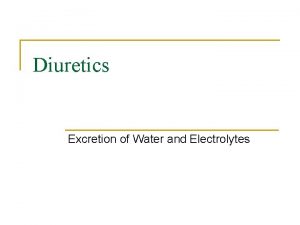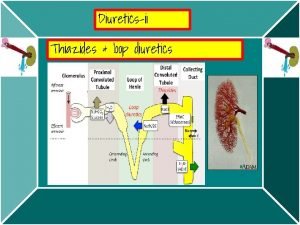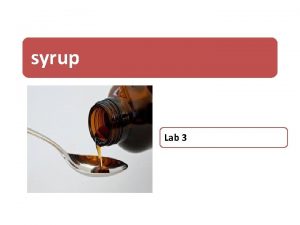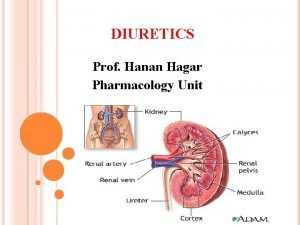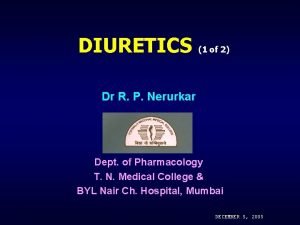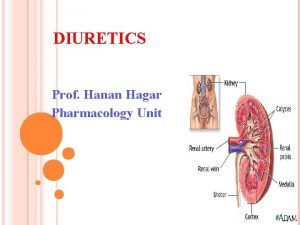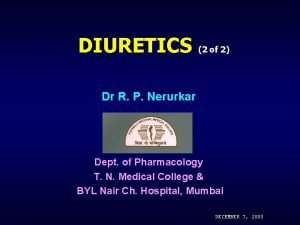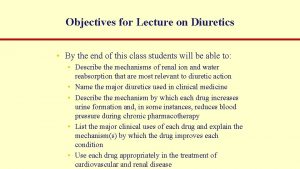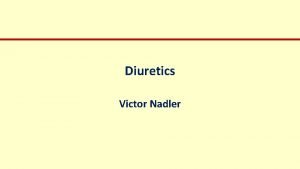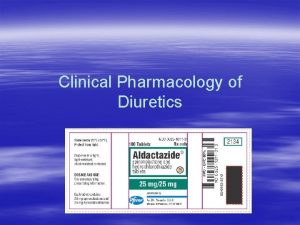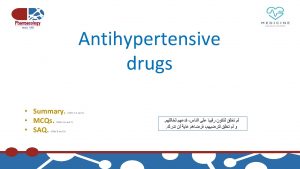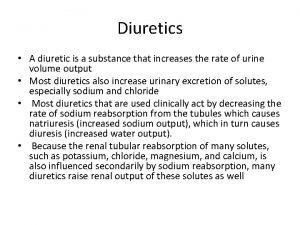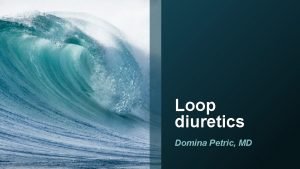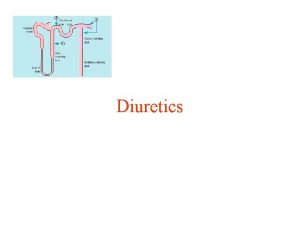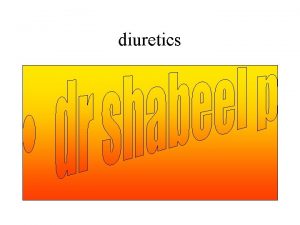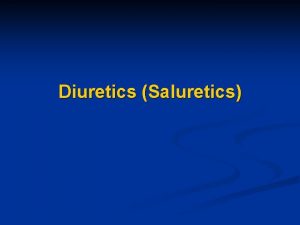Chapter 51 Diuretic Agents Classes of Diuretics Thiazide















- Slides: 15

Chapter 51 Diuretic Agents

Classes of Diuretics • Thiazide and thiazide-like diuretics • Loop diuretics • Carbonic anhydrase inhibitors • Potassium-sparing diuretics • Osmotic diuretics

Function of Diuretic Agents • Increase the amount of urine produced by the kidneys • Increase sodium excretion

Indications for Diuretic Use • Edema associated with congestive heart failure • Acute pulmonary edema • Liver disease (including cirrhosis) • Renal disease • Hypertension • Conditions that cause hyperkalemia

Causes of Edema and Ascites in Patients With Liver Failure • Reduced plasma protein production – Results in less oncotic pull in the vascular system and fluid loss at the capillary level • Obstructed blood flow through the portal system – Caused by increased pressure from congested hepatic vessels

Thiazide and Thiazide-Like Diuretics • Hydrochlorothiazide (Hydro. DIURIL) • Chlorothiazide (Diuril) • Bendroflumethiazide (Naturetin) • Benzthiazide (Exna) • Hydroflumethiazide (Diucardin) • Methyclothiazide (Aquatensen) • Polythiazide (Renese) • Trichlormethiazide (Diurese)

Sites of Action of Diuretics in the Nephron

Indications for Thiazide and Thiazide-Like Diuretics • Treatment of edema associated with CHF, liver, or renal disease • Monotherapy or adjuncts for the treatment of hypertension

Focus on the Prototype Thiazide Diuretic: Hydrochlorothiazide • Indications: Adjunctive therapy for edema associated with CHG, cirrhosis, corticosteroid and estrogen therapy, and renal dysfunction; treatment of hypertension • Actions: Inhibits reabsorption of sodium and chloride in distal renal tubules, increasing the excretion of sodium, chloride, and water by the kidneys • Oral route: Onset 2 h; peak 4– 6 h; duration 6– 12 h • T½: 5. 6– 14 h; metabolized in the liver and excreted in urine

Loop Diuretics Currently Available • Furosemide (Lasix) – Most commonly used; less powerful than new drugs; larger margin of safety for home use • Bumetanide (Bumex) and torsemide (Demadex) – New drugs; more powerful than Lasix • Ethacrynic acid (Edecrin) – First loop diuretic introduced, used less frequently in the clinical setting

Indications for Loop Diuretics • Acute CHF • Acute pulmonary edema • Edema associated with CHF • Edema associated with renal or liver disease • Hypertension

Focus on the Loop Diuretic Prototype: Furosemide • Indications: Treatment of edema associated with CHF, acute pulmonary edema, hypertension • Actions: Inhibits reabsorption of sodium and chloride from the proximal and distal renal tubules and the loop of Henle, leading to a sodium-rich diuresis • Oral route: Onset 60 min; peak 60– 120 min; duration 6 – 8 h • IV, IM route: Onset 5 min; peak 30 min; duration 2 h • T½: 120 min; metabolized in the liver and excreted in urine

Focus on the Carbonic Anhydrase Inhibitors Prototype: Acetazolamide (Diamox) • Indications: Treatment of glaucoma; edema caused by CHF, drug-induced edema; centrencephalic epilepsy; prophylaxis and treatment of acute altitude sickness • Actions: Inhibits carbonic anhydrase, which decreases aqueous humor formation in the eye; intraocular pressure and hydrogen secretion by the renal tubules • Routes: Oral, SR, IV • T½: 5– 6 hr; excreted unchanged in urine

Potassium-Sparing Diuretics • Types – Amiloride (Midamor) – Spironolactone (Aldactone) – Triamterene (Dyrenium) • Uses – Patients at high risk for hypokalemia associated with diuretic use

Osmotic Diuretics • Types – Glycerin (Osmoglyn), Isosorbide (Ismotic), Mannitol (Osmitrol), and Urea (Ureaphil) • Action – Pull water into the renal tubule without sodium loss • Indications – Increased cranial pressure or acute renal failure due to shock, drug overdose, or trauma
 Isothenuria
Isothenuria Potassium sparing diuretics mechanism of action
Potassium sparing diuretics mechanism of action Thiazide
Thiazide Dry gum and wet gum method
Dry gum and wet gum method Syrup lab
Syrup lab Diuretic side effects
Diuretic side effects Diuretic drugs classification
Diuretic drugs classification Diuretics classification
Diuretics classification Diuretic location of action
Diuretic location of action Hyperuricemia classification
Hyperuricemia classification Spironolactone moa
Spironolactone moa Classe e subclasse de em
Classe e subclasse de em Pre ap classes vs regular classes
Pre ap classes vs regular classes Loop diuretics adverse effects
Loop diuretics adverse effects Acidifiers and alkalinizers
Acidifiers and alkalinizers Loop diuretics adverse effects
Loop diuretics adverse effects

